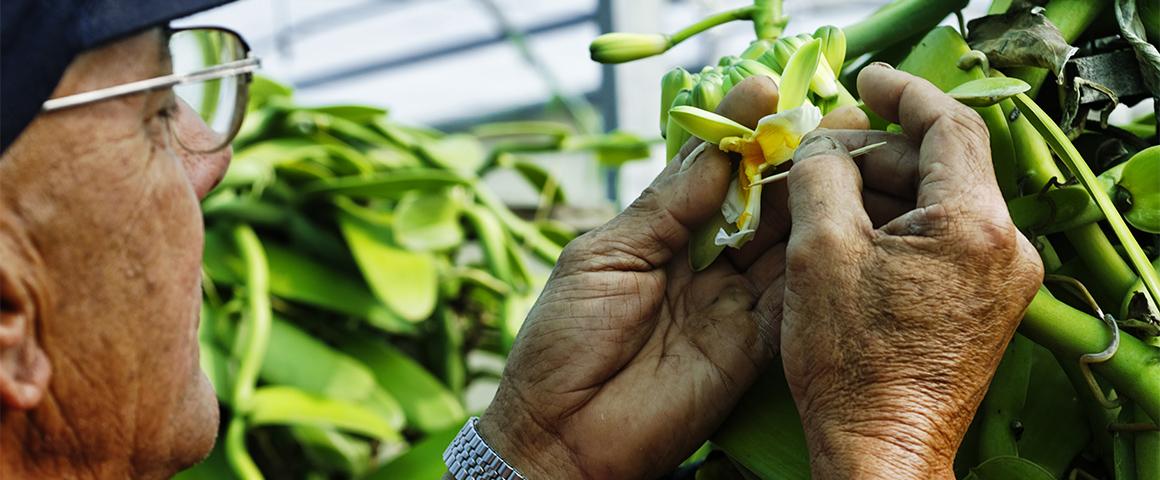Results & impact 10 October 2025
- Home
- Press area
- Press releases
- Genetic heritage of vanilla
83% of the genetic heritage of vanilla has been determined

Vanilla plant of CIRAD’s Vatel Biological Resource Centre (BRC) © R. Carayol, CIRAD
The sequence of virtually the entire genome of Vanilla planifolia, the species that provides one of the world’s most widely consumed flavourings, is now available to the public and to researchers. This discovery is the result of four years of research by a French consortium comprising two private firms, Eurovanille and V. MANE FILS, and six public research organizations: CIRAD, the University of La Réunion, INRAE, CNRS, Paris-Saclay University and Etablissement Vanille de Tahiti.
More than 59 000 genes identified
This vast sequencing operation began in 2017, and served to compile a catalogue of more than 59 000 genes from the world’s most widely cultivated vanilla species. Quentin Piet, a genetics PhD student at CIRAD and the University of La Réunion and lead author of the study, points out that: “Only a third of the Vanilla planifolia genome had been sequenced until now. Our work served to cover 83% of the genome and to determine gene structure in much greater detail. For instance, we now know that vanilla has sixteen pairs of chromosomes, whereas previous studies had hesitated between fourteen and sixteen”.
The vanilla genome has inherited a very specific genetic characteristic from plants in the orchid family: partial endoreplication, which makes it difficult to sequence. “The cells of living beings often have nuclei containing several copies of their genomic DNA”, Quentin Piet explains. “In most of the beings that exhibit the phenomenon, DNA replication is total. However, in vanilla, only part of the genome is replicated in the nucleus, up to 64 times, while the rest stays as it is. In Vanilla planifolia, the non-replicated part accounts for 72% of its DNA! That part of the genome therefore finds itself in vastly in the minority within the genome, and is difficult to access with sequencing tools.”
To at least partly overcome that difficulty, the scientists used tissues rich in nuclei whose DNA was not significantly replicated, in other words vanilla plant nodes. The plants used were propagated in vitro, and came from the vanilla collection held by CIRAD’s Vatel Biological Resource Centre (BRC).
This unique collection was set up in 2004, and contains more than 500 vanilla varieties (500 accessions) and 250 specimens from some thirty vanilla species representative of central and Latin America, Africa and Asia. For Carine Charron, a geneticist with CIRAD, co-author of the study and manager of the collection, it has two aims: “to play a part in conserving that biodiversity, and also to be able to learn something from it, either for scientific purposes or in order to make it available to producers”.
To this end, the results of the sequencing operation have been made public and are available via the Vanilla Genome Hub online platform.
Towards new vanilla varieties?
A better understanding of the genome is vital for varietal improvement of a crop whose diversity is currently very limited, notably via the identification of genes that could benefit the sector, for instance those coding for the synthesis of vanillin, a major vanilla flavour component, or for disease resistance.
“Breeding a new vanilla variety from seed takes between seven and eight years per generation”, says Michel Grisoni, a CIRAD researcher and co-author of the study. “We are talking of a long-term process before we can offer producers new varieties. To save time, we need to choose parents with the right genes and rapidly breed the most promising progenies. This is why it is vital to know the genome inside out”.
In particular, CIRAD and its partners are working to develop a vanilla variety with greater resistance to stem rot, a worldwide disease caused by a soil fungus that can kill up to 67% of the plants in a plantation.
“Being able to use the scientific progress made in this research to develop more vigorous, resistant and productive vanilla varieties would really benefit our industry, as it could have a significant impact on the quality and price of the pods produced”, say Laurent Bourgois (Eurovanille) and Joseph Zucca (V. MANE FILS).
There are some 120 vanilla species worldwide, of which around twenty produce fruits with aromatic properties. Currently, almost 98% of the vanilla sold in the world comes from a single species, Vanilla planifolia. Vanilla tahitensis, the Tahitian vanilla makes up the remaining 2%.
France is the world’s third leading vanilla importing country, behind the USA and Canada, while some 80% of global output comes from Madagascar.
Reference
Piet Q., Droc G., Marande W., Sarah G., Bocs S., Klopp C., Bourge M., Siljak-Yakovlev S., Bouchez O., Lopez-Roques C., Lepers-Andrzejewski S., Bourgois L., Zucca J., Dron M., Besse P., Grisoni M., Jourda C., and Charron C. 2022. A chromosome-level, haplotype-phased genome assembly for Vanilla planifolia highlights that partial endoreplication challenges accurate whole genome assembly. Plant Communications. DOI: 10.1016/j.xplc.2022.100330



























